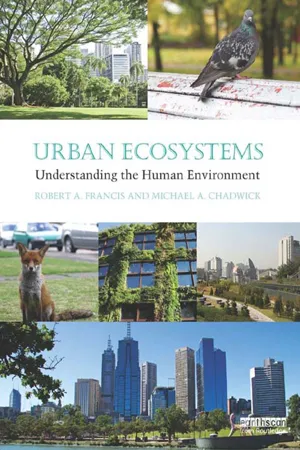Habitat Creation
Habitat creation refers to the intentional or unintentional process of establishing or restoring a suitable environment for specific organisms to live and thrive. This can involve modifying existing landscapes or creating entirely new habitats to support biodiversity and ecological balance. Habitat creation initiatives are often undertaken to mitigate the impact of human activities on natural ecosystems and to promote conservation efforts.
3 Key excerpts on "Habitat Creation"
- eBook - ePub
Urban Ecosystems
Understanding the Human Environment
- Robert A. Francis, Michael A. Chadwick(Authors)
- 2013(Publication Date)
- Routledge(Publisher)
...Habitat Creation, creative conservation and landscaping for biodiversity are now becoming common in urban parks (e.g.Gobster, 2001). Even in heavily used parks and recreational areas, more modest kinds of sympathetic management for biodiversity may include the planting of wild flower gardens or grassland areas, trees (including snags) that support the foraging or nesting of specific bird taxa, or establishing vegetated and tree-lined buffer areas along streams or other natural corridors within parks to support small mammal populations (Mahan and O'Connell, 2005; Sandström et al., 2006). Such habitat modifications are easily compatible with both recreational and educational uses and can be performed over larger spatial areas and potentially with greater coordination in urban parks and other public recreational areas than on living roofs, walls, and private gardens. However, as most parks and recreational spaces are public owned, this larger scale of reconciliation will require a different level of commitment and has less potential to be driven by the local actions of interested citizens. Nevertheless, parks may represent a nucleus for reconciliation techniques and biodiversity support that local action can enhance, for example by garden management (Colding, 2007; Forman, 2008). Gardens are highly variable in their size, shape, management, habitat provision and position within the landscape and offer good opportunities for reconciliation (Goddard et al., 2010). Gaston et al. (2005b) conducted experimental tests of habitat improvement methods in urban gardens and found that the addition of simple artificial nest sites, small plastic ponds and patches of nettles encouraged the presence of a range of invertebrates, though some additions were more effective than others...
- eBook - ePub
Urban Nature Conservation
Landscape Management in the Urban Countryside
- Stephen Forbes, Tony Kendle(Authors)
- 2013(Publication Date)
- Taylor & Francis(Publisher)
...The objective that planners often have in this regard is to influence, through zoning, incentives or control of consent for development, the pattern of the landscape. Planners have few opportunities for initiating positive development. There have of course been an increasing number of cases where Habitat Creation is associated with developments, as part of planning gain. This can play a part in achieving the ‘ideal’ habitat pattern suggested by landscape ecology. The issue is discussed in more detail in Chapter 6, but a key objective should be to strengthen the viability of existing habitats. Nevertheless, planners are usually constrained by the need to wait for development proposals to be forwarded before such goals can be realized, and by limitations on the extent to which they can tell developers what form of scheme should be forwarded (Selman, 1992). Of course the powers to purchase land, and even compulsory purchase, do exist but these are rarely employed except for the protection of high-quality, existing sites of nature conservation interest since urban land prices are disproportionate to the benefits that may accrue from planned purchase of lower grade sites. There is another strategic approach for maintaining diversity in fragmented systems, which is to influence process by direct management. For example the tendency for habitat isolation to increase the risk of localized species extinction can clearly be directly addressed by policies of species re-introduction. Similarly the population carrying capacity of small areas may be increased by provision of additional artificial resources such as nest boxes or even extra food. Management control of habitat quality is therefore a key issue in the conservation of habitats, both urban and rural...
- eBook - ePub
- Karen Holl(Author)
- 2020(Publication Date)
- Island Press(Publisher)
...When a person’s house is burglarized, a primary concern is to improve security so that the act is not repeated, but improving security does not lessen the need to replace stolen items. Of course, there may be no substitutes for certain items such as photographs or other memorabilia, but the owners normally do their best to re-create the house as it was before the vandalism. Likewise, conservation and restoration are not mutually exclusive; they are complementary actions. In general, the field of conservation biology has become more hands-on in recent years (Hobbs et al. 2011); actions are increasingly taken to maintain existing habitats both proactively (e.g., preventing invasive species from colonizing existing habitats) and reactively (e.g., removing invasive species). Whereas restoration may mitigate some anthropogenic impacts on the natural world, restoration is a useless exercise unless it is part of an effort to reduce the drivers of habitat conversion, which are complex and vary across the globe (Geist et al. 2006). The human population continues to grow rapidly, having increased by 1.6 billion people between 2000 and 2019, and we are adding approximately 200,000 additional people to the planet each day. Likewise, high levels of consumption in places like the United States and Europe and growing levels of consumption in nations such as China and Brazil increase human impacts on ecosystems. Complex patterns of global trade and rural-urban migration, as well as new technologies, interact to affect land use patterns (Lambin and Meyfroidt 2011). Although a detailed discussion of how to reduce these drivers of habitat degradation and conversion is beyond the scope of the book, it is critical to recognize that ecological restoration has to be a part of multifaceted efforts to conserve ecosystems while providing for human livelihoods...


